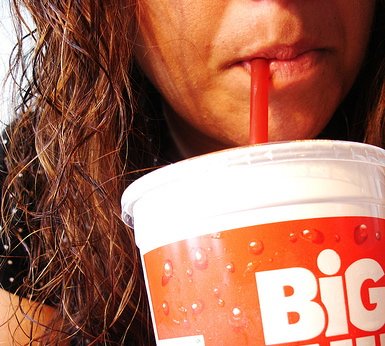
Ironically, 7-Eleven stores are actually exempt from the ban. (Photo by Shelly Munkberg.)
If the food police has a chief, it may very well be New York City Mayor Michael Bloomberg. His battles with the food industry are quickly becoming the stuff of legend. And his latest gambit is his boldest yet: Bloomberg just announced a plan to ban the sale of any sweetened beverage over 16 ounces at all restaurants, delis, and sports arenas in New York City.
And just so the soda industry doesn’t feel singled out, this ban would apply to sports drinks and sweetened iced tea, along with pretty much anything with added sugars — although the Starbucks Frappucino likely makes it through on a technicality; dairy products like it (as well as fruit juice, “diet” drinks, and booze) are exempted.
This latest move comes on the heels of the city’s successful (and much copied) trans fat ban, as well as its public media campaign against soda called “Don’t Drink Yourself Fat” — not to mention its proposal to limit salt in processed food. In fact, the Centers for Disease Control confirmed recently that these and many other efforts may be starting to pay off for the Big Apple. The obesity rate in NYC among kids dropped 5 percent over the last five years.
So why enact an outright ban on large drinks when there’s evidence [PDF] that a penny-per-ounce soda tax would have cut consumption while generating needed revenue for the public coffers? Do you really have to ask?
The short answer is because it would be impossible to get one passed — thanks in large part to the efforts of the deep-pocketed members of the American Beverage Association (ABA). PepsiCo was willing to spend $40 million in a single year to help kill a federal soda tax, while the ABA itself buried a proposed Philadelphia soda tax through a $10 million donation to a local hospital’s anti-obesity efforts. And now comes word of Pepsi’s plan to co-opt the youth of the world by hosting “live-streamed concerts” on Twitter. Wait. Concerts? On Twitter? Just win, baby.
Of course, seen from a different perspective, a ban isn’t so different from a tax. If you really want more than 16 ounces of soda, you can have it — you just have to pay for it, with one big exception. Free refills at restaurants (or presumably at any place with a soda fountain) will still be legal. But — if it goes into effect as planned next March — this ban has the potential to be a game-changer.
And not just because fast-food portion sizes have massively increased over the last 50 years, as Grist recently reported. Sarah Kliff at the Washington Post observes that there’s also ample evidence that portion size itself influences how much you eat, independent of how hungry you are:
In one well-known experiment, Philadelphia moviegoers were given either a medium or large bucket of stale, two-week old popcorn. Those with the large bucket ate 33.6 percent more popcorn, despite the fact it tasted pretty awful. When the package size of a snack food is doubled, calories consumed tend to go up by about a third [PDF].
“The more general explanation of why large packages and portions increase consumption may be that they suggest larger consumption norms,” writes [PDF] Cornell University’s Brian Wansink, who has pioneered much of the research on food portion size. “They implicitly suggest what might be construed as a “normal” or ‘appropriate’ amount to consume.”
On the flipside, when portions get reduced, calorie consumption goes down. Belgian researchers recently looked at what happened when they cut a group of schoolchildren’s cookies in half. They found that the simple act of splitting cookies into smaller pieces — even while offering kids the same total number of calories — reduced consumption by 25 percent.
It’s this phenomenon that Bloomberg’s proposal directly addresses. The point isn’t that the ban is impossible to game — you can obviously still find a way to get 42 ounces (!!!) of soda at a time if you really want it. You can, for example, get two-liter bottles at the grocery store or hang out at restaurants that offer free refills. But the psychological effect of smaller portions might actually kill the urge to drink so much of the stuff.
Of course, just as with other attempts to restrict or tax sweetened beverages, this one will have to withstand the soda lobby’s efforts. Working in New York City’s favor is the fact that its Board of Health is the only body whose vote is required for approval — and Bloomberg handpicked all of its members. That won’t stop beverage companies or retailers from suing, though. And I won’t be surprised if opponents of the ban attempt to get the New York City Council to pass an ordinance overturning it.
Still, considering the fact that so many of our federal agencies have fallen prey to the “obesity lobby,” it’s heartening to see New York City pioneering new ways to cut down on junk food. And who knows? This one just might work.


